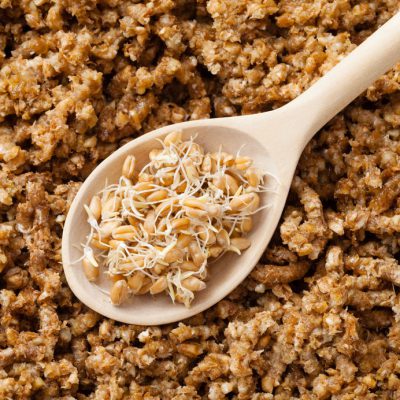
Sprouted grains are ground down before being used in products.Sprouted grains are believed to be nutritionally superior to non-sprouted grains. Just take a look at their rising popularity. The key benefits claimed for sprouting are:
- Increased amount of vitamins and minerals
- Increased bioavailability of vitamins and minerals
- Rich source of fiber
- Increased digestibility
However, does the research back up those claims? Let’s take a closer look:
Do sprouted grains contain more vitamins and minerals?
The existing scientific evidence suggests that this statement needs to be balanced. Scientific literature shows that sprouted grains (and legumes) have the potential to show higher values of several vitamins and minerals (such as B94 and calcium9). However, the actual result seems to depend on the type of grain and the process.3,5,7
In other words, sprouting can have a significant impact on the nutritional values of foods, but this is not always the case!
Are vitamins and minerals in sprouted grains more bioavailable?
Some foods contain anti-nutritional factors, i.e., substances that interfere with the utilization of nutrients by our bodies. Whole grains, seeds, legumes and beans, for instance, contain significant amounts of phytates, which are well known to inhibit mineral absorption. Phytates can form complexes with vitamins and minerals that can make these nutrients less available for absorption by the body. So if phytates are degraded in the sprouting process, this may improve mineral bioavailability.
The degradation of phytates during sprouting/germination has been observed in many studies, and with different grains. It seems that the longer the grains germinate, the more degradation in phytates occurs. For instance, some studies have shown a reduction of around 20-30% after 4 days of germination, with as much as 80-85% reduction after 10 days.2
However, only two human studies have addressed the question of whether sprouted foods result in better mineral absorption. In one study, Tanzanian children consumed sprouted millet as porridge. The results showed no effect on their iron status.8 The other study gave healthy humans malted/sprouted oat porridge containing 77% less phytate than non-malted oat porridge. The result? The study subjects doubled their zinc absorption.6
Taken together, the existing data do suggest that the process of sprouting can enhance absorption of minerals, thanks to phytate degradation. However, more data in humans are needed to confirm this.
Are sprouted grains a rich source of fiber?
Because sprouted grains are originally whole grains, they contain many of the same benefits, including fiber-richness. However, efforts to establish superiority in fiber content of sprouted grains have been inconsistent. Studies of several different grains have sometimes found relatively more fiber in sprouted grains, sometimes less, and other times no difference.7
Are sprouted grains easier to digest than non-sprouted grains?
There is good evidence (from in vitro studies) that sprouted grains may be more digestible. This is likely because during the germination process, complex molecules are broken down into smaller ones.7 However, this seems, again, to depend on the type of grain and on the germination process. Today there is a lack of data confirming that the compositional changes observed in sprouted grains actually make them easier to digest than non-sprouted grains. Similarly, there are no available clinical data investigating the impact of sprouted versus non-sprouted grains on digestive comfort (e.g., reductions in abdominal pain, cramping, or bloating).1
And the verdict is…
From the available research, we can conclude that germination/sprouting alters the nutritional properties of grains. However, the precise nutritional composition of sprouted grains as a group is unclear, as it varies with the type of grain and germination conditions. Data tend to show a beneficial effect of sprouting, but this need to be confirmed via additional research in humans.
References
- Afify AMR, El-Beltagi HS, El-Salam SMA, Omran, AA. (2012). Protein solubility, digestibility and fractionation after germination of sorghum varieties. PLOS ONE, 7(2), e31154.
- Azeke MA, Egielewa SJ, Eigbogbo MU, Ihimire, IG. (2011). Effect of germination on the phytase activity, phytate and total phosphorus contents of rice (Oryza sativa), maize (Zea mays), millet (Panicum miliaceum), sorghum (Sorghum bicolor) and wheat (Triticum aestivum). Journal of Food Science and Technology, 48(6), 724-729.
- Coulibaly A, Chen, J. (2011). Evolution of energetic compounds, antioxidant capacity, some vitamins and minerals, phytase and amylase activity during the germination of foxtail millet. American Journal of Food Technology, 6(1), 40-51.
- Hefni M, Witthöft CM. (2012). Effect of germination and subsequent oven-drying on folate content in different wheat and rye cultivars. Journal of Cereal Science, 56(2), 374-378.
- Katina K, Liukkonen K-H, Kaukovirta-Norja A, Adlercreutz H, Heinonen S-M, Lampi A-M, . . . Poutanen, K. (2007). Fermentation-induced changes in the nutritional value of native or germinated rye. Journal of Cereal Science, 46(3), 348-355.
- Larsson M, Rossander-Hulthén L, Sandström B, Sandberg, A. (1996). Improved zinc and iron absorption from breakfast meals containing malted oats with reduced phytate content. British Journal of Nutrition, 76(05), 677-688.
- Nelson K, Stojanovska L, Vasiljevic T, Mathai M. (2013). Germinated grains: a superior whole grain functional food? 1. Canadian Journal of Physiology and Pharmacology, 91(6), 429-441.
- Tatala S, Ndossi G, Ash D, Mamiro P. (2007). Effect of germination of finger millet on nutritional value of foods and effect of food supplement on nutrition and anaemia status in Tanzania children. Tanzania Journal of Health Research, 9(2), 77-86.
- Tizazu S, Urga K, Belay A Abuye C, & Retta N. (2011). Effect of germination on mineral bioavailability of sorghum-based complementary foods. African Journal of Food, Agriculture, Nutrition and Development, 11(5), 5083-5095.

